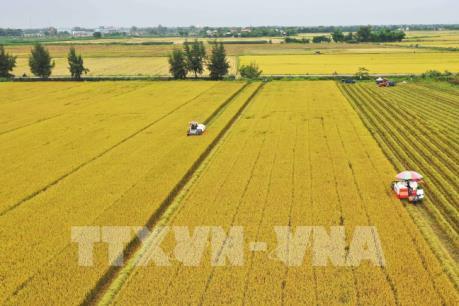 Economy
Economy


|
| Large-scale rice fields in An Giang Province’s Tri Tôn District. VNA.VNS Photo |
AN GIANG – The Gross Regional Domestic Product (GRDP) of An Giang Province grew 6.3 per cent in the first three months, the fifth-highest among provinces of the Mekong Delta region.
Phạm Minh Tâm, director of the provincial Department of Planning and Investment, said that in the first three months of the year, industrial production in An Giang recovered strongly. In particular, the index of industrial production increased by 9.71 per cent over the same period a year ago.
In addition, commercial activities were also bustling again, with total retail sales of goods and services reaching VNĐ49 trillion (US$2.09 billion), up 16 per cent over the same period last year.
An Giang's export activities also had many positive signs, with export turnover reaching $285 million, up 7.3 per cent from last year. The main export items of An Giang Province all increased compared to the same period in 2022 in terms of both output and turnover, thanks to the Chinese market reopening, which boosted the export of agricultural and aquatic products, especially pangasius products.
In the first three months of the year, An Giang's tourism industry welcomed 4 million tourists, an increase of 60 per cent from a year earlier to reach 50 per cent of the goal for 2023. State budget revenue reached VNĐ2.19 trillion, reaching nearly 33 per cent of the year's target, an increase of over 3.2 per cent over the same period in 2023.
In the first six months of 2023, An Giang aims to increase GRDP between 6.94 per cent and 7.4 per cent, and for all of 2023 between 7 per cent and 7.5 per cent.
To achieve this, it will focus on the development of hi-tech agriculture, concentrated growing areas and linkages between stakeholders to increase value, according to its People’s Committee.
It will speed up restructuring of agriculture, including river-based aquaculture, expand cultivation of high-quality rice varieties and switch to high-value crops on unproductive rice fields.
It will develop concentrated growing areas for some key agricultural items, including 10,217ha of fruits, 6,000ha of vegetables and 1,500ha of tra catfish, by 2025.
Situated in the centre of the delta, on the border with Cambodia, and a gateway to Cần Thơ City and HCM City, An Giang has great economic potential.
It has identified agriculture as the basis of its economy and is soliciting investment in key items such as rice, tra fish, fruits and vegetables.
It will strengthen advocacy activities to apprise companies, co-operatives, co-operative groups, and households about its incentives and attract their investment in agriculture and rural development.
Farmlands account for more than 80 per cent of the province’s area, and it has abundant freshwater throughout the year for agriculture, especially rice.
For exports, the province has 211 agricultural co-operatives with a total of 13,269 members and 960 co-operative groups with a total of 15,213 members.
It is granting production codes for fruits and other crop growing areas to meet export demand.
To get a production code, there has to be a minimum area of 10ha and farming on it should conform to Vietnamese good agricultural practices (VietGAP) or other equivalent standards.
The province has issued codes to 434 areas where rice, fruits and vegetables are grown as of last year, and their produce is exported to the US, South Korea, New Zealand, Japan, China and some other markets.
It plans to issue 617 more codes for rice and glutinous rice, 130 for vegetables and 83 for fruits this year.
It has identified four main fruits - mango, banana, longan, and citrus varieties. – VNS